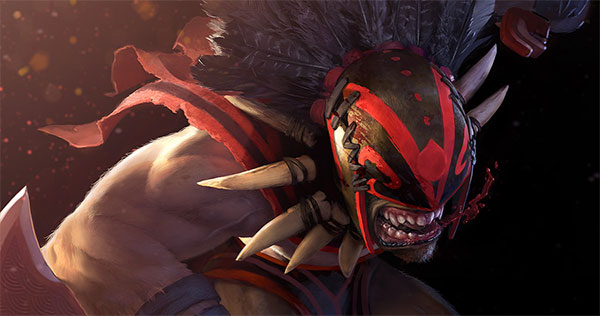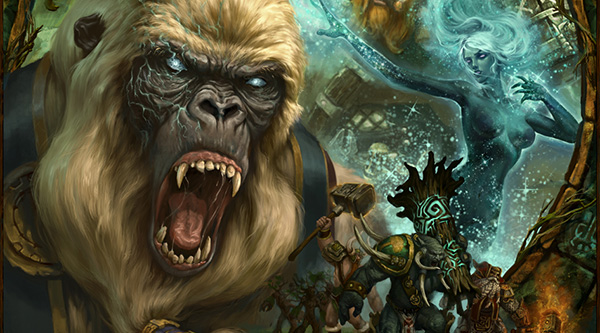A Brief History Of The Battle Arena, Part One
Towers To Defend
Inspired by DOTA2 and League Of Legends soaring in popularity, and dominating the pro-gaming world, Yannick LeJacq decided to take a look at where Battle Arenas came from, and how history had conspired to make this the most competitive genre in PC gaming. Read on for his history. Obviously it's not comprehensive, these are just Yannick's own impressions - hence "brief" history - from conversations from people who were involved over the years.
In the game industry, as with any industry, success is usually defined by numbers. Big numbers, that is. And today, few if any game companies can boast more impressive figures than developers like Valve Software, Riot Games, and S2 Games.
To give a quick example, I recently attended a conference in New York City to speak at a panel boldly titled “The New Economics of the Game Industry.” The people in attendance were a mixture of big media types, business analysts, and eager members of New York’s startup scene. The elephant in the room was the bitter fact that the traditional retail models of console and computer gaming was trembling in the wake of free-to-play’s challenge. Confidence in an entirely freemium marketplace, however, has been shaken by Zynga’s post-IPO erraticism. In response, I mentioned Riot Games’ flagship title, “League of Legends.” Possibly because he noticed confused looks across the audience, one the other panelists said Riot is “the most successful game company you’ve probably never heard of.”

Of course for anyone who plays games on their PC (and not just on Facebook) regularly, Riot is not an obscure company. But his statement illustrates the quiet revolution that companies like it have sparked in little more than five years. Along with that, they've also reasserted the prominence of the PC gaming despite ever-present debates about the desktop computer’s future viability. As the rest of the game industry is stuck in an identity crisis between making “casual” and “hardcore” games (the new buzzphrase seems to be “console quality midcore games,” don’t ask me why), selling their products or figuring out more clever ways to make money off of them, Riot, Valve, and S2 have attracted millions of fiercely devoted fans and, in return, handed out millions of dollars in prize money to their best players.
In August, Valve told me, the company had about 1.5 million unique users logging into to its server to play a game that hasn't even been released yet. By its latest calculation in 2011, Riot Games had more than 11 million active players, with about 1.3 million playing at any given time. These numbers may still pale in comparison to, say, Zynga's mammoth presence on Facebook. But then you haven’t heard about many C-level departures or insider trading lawsuits at Valve.

What is the magic recipe? One word: MOBAs. Well, okay, maybe that's four words. But the point is that the secret sauce lies somewhere in the term “multiplayer online battle arena,” a phrase that even the developers themselves admit doesn't make much sense. The phrase “MOBA” itself, when picked apart, just sounds like a bunch of gamers wailing on each other. And that could describe anything from the highest level match of Starcraft 2 to Words With Friends.
So where did this genre without a real name come from, exactly? Who, or what, first sowed the seeds of its quiet revolution? To understand what a MOBA is, exactly, one can only look back to how they were first created.
Ascent of the Ancients
Like any story of a vibrant online community being snatched up by commercial interests, the exact origin of MOBAs is a murky tale. Many of the formative figures who created the genre’s first games now work at the companies that caught an early whiff of its immense potential, and thus remain shielded behind a wall of PR and intellectual property tip-toing. And like any knowledge produced on a rapidly evolving digital platform online, much of the potential archival material is lost to information decay. Even the name “MOBA” itself is subject of myth-making and bickering across countless forums dedicated to its core games. A lot of the knowledge that exists today about MOBAs therefore lives on thanks to the memory and history of the original DotA myth itself, a name still so resonant that many casual onlookers confuse it with the genre itself.
DotA stands for “Defense of the Ancients,” and is by many accounts the most popular game borne out of the modern institutionalized game factory to never have a proper commercial release. But even DotA came from a much smaller slice of the modding community for Blizzard’s original “Starcraft.” Being one of the most important games ever made in the real-time strategy genre, “Starcraft” had a natural advantage of a rapt audience and a fiercely competitive online community that prided itself on customization — using units in unconventional ways to surprise opponents, and of course designing the most effective and intricate maps for matches.

But the Aeon Of Strife map took this one step further into the customization territory by departing from base-building and unit management entirely. Instead of running a factory to churn out new marines or zerglings to rush the opponent, the player was handed a single overpowered hero unit, like the unique characters that peppered the original Starcraft campaign. The base still existed, but all of the minutiae of upgrading buildings and producing units was left to the AI, which periodically sent the units down three different lanes. Towers were peppered throughout each of the lanes, and the player’s task was to destroy the towers and eventually destroy the opponents base itself.
That still defines most of what happens in any given MOBA. But it says nothing of the intricacy or intense difficulty of any given match. Nor does it explain why they’ve proved so captivating. Tapping into the ferocity of the gamer-cum-tactician-cum-professional athlete was certainly part of it. But it also located a much deeper need for a new type of game, as evidenced by the frequent botched attempts to mix the rough-and-tumble elements of action games with the dorky, data-driven intricacies of any RTS or RPG. Take any of the botched attempts to wed the two even just by name alone — the unfortunate Command and Conquer: Renegade, the non-existent Starcraft: Ghost, even (forgive me for bringing consoles into this) the Shaolin-styled Dynasty Warriors — and you’ll see the same urge to be in a battle rather than simply overseeing one. Suddenly, gamers had a way to do both. And they could do it all in the closest thing videogames yet had to Calvinball, making up the rules as they went along.
One DotA To Rule Them All
In 2003 with the aid of the same Blizzard modding community that first populated Aeon Of Strife, as angry Starcraft fans realized that Starcraft 2 wasn’t coming as soon as anybody thought or hoped, the game transferred over to the company’s newest RTS game, Warcarft III: Reign of Chaos. A particularly eager and talented modder that went by the handle Eul built a map in the AoS tradition that would support five versus five matches, and bequeathed it the title Defense of the Ancients.
DotA introduced more RPG elements than AoS originally offered. Units now gained experience and cash for killing creeps and the opposing heroes, earning different metrics that went towards advancing and customizing hero characters. The RTS flavor was preserved in the isometric perspective itself as well as the keen sense of timing and tactical advance the games required. The death of a hero, for instance, resulted in a lag until a teammate could get back up to fighting speed, offering valuable seconds to exploit any hold in the enemy’s defenses.

Eul stepped down from the reins shortly after DotA was first released to the internet, and his place was soon taken by Steve Feak, who went by the handle Guinsoo. Shortly thereafter, Steve Mescon, better known as "Pendragon," joined him. Guinsoo developed the robust infrastructure for the game, adding layers upons layers of new items and abilities, heroes and neutral characters pooled from all the different mods he saw pop up around the original DotA concept. Pendragon, meanwhile, built the forum that first created a townhall for the vast DotA collective that gathered around Guinsoo’s version, which he called “DotA Allstars” to solidify its position above the fray of a massive and distended modding community.
A MOBA By Any Other Name?
By 2005, DotA’s rapid growth had drawn the curiosity of prospectors. About a dozen developers at Gas Powered Games, creators of the first few Dungeon Siege titles, had started playing the game during their lunch breaks. “It seemed a shame that nobody had ever brought that intensity of gameplay to a finished market product,” Bert Bingham, a producer at the company recalls. By December the following year, they had assembled a pitch for a DotA-inspired game they called Dungeon Siege Commander.
That same year, Riot Games was founded by Brandon Beck and Marc Merrill, two unabashed gamers with strong business acumen. Tom Caldwell, Riot’s design director, remembers the team seeing DotA and thinking that “the primordial soup was there” for something much larger. But like GPG, Riot also noticed the limitations of supporting such an immense community on mods alone.
“We believed that a standalone game could bring players much-needed functionality like matchmaking, persistent game features, and so on,” Caldwell tells me in an email. “And we also believed there was a ton of room for exploration and improvement in terms of game design there.”
By 2007, Gas Powered Games had given the greenlight to their office DotA fans, and the company began production for a game they’d recast as a unique IP named Demigod. The same year, both Guinsoo and Pendragon joined Riot Games to begin work on League of Legends. By that point, control over the original DotA All-Stars had been handed over to Abdul Ismail, an obscure figure who went by the name “IceFrog.” Rather than focusing on adding droves of new content like his predecessors, IceFrog approached his work with a ruthlessly focused editorial mindset, constantly tweaking and adjusting the game to make it as fine-tuned and balanced as the classic Blizzard titles from which it was born. And alongside his work, Pendragon’s original community continued to grow.

The problem each of these teams faced, of course, was that they had little more to go on in terms of guidance than the name “DotA” itself. Recalling the time now, all of the developers admit they had no sense of the term “MOBA” at all. And working in isolation from one another, they lacked the natural cross-fertilization of ideas a selflessly devoted horde of modders and eager forum users can offer.
“There were really only two datapoints to draw from by the time we released Demigod,” Bingham says, referring to DotA and Demigod itself (the team wasn't even aware of Aeon of Strife at the time). “Tower Defense and Action-RTS were the terms we used back then interchangeably,” he adds when I ask him how they described the project. “Environmentally augmented team PvP was really our spiritual objective.” At first, they only considered AI-driven creeps to be the essential ingredient to retain from DotA, though Bingham notes that towers quickly became “essential to lock down the starting landscape.”
GPG thus approached Demigod with their design mentality as creators of role-playing games. Bingham explains that they wanted to “deepen the character depth and add more complex advancement schemes for both the Demigods, and the team.” They created a comparatively small set of hero characters — 8 upon initial release — and a wider variety of maps, each component offering greater depth than their predecessors could afford.
Riot, meanwhile, wanted to make League of Legends a sport from the very beginning. Describing the initial iterations of the game, Caldwell says the team hoped to move away from some of the “rock, paper, scissors” mechanics that often describe RTS games. For the original mods, he felt the pre-existing design meant “decisions made at champion [selection] or in the purchase of a particular item would pre-destine a particular engagement, or one specific ability could determine a fight entirely and effectively strip out the opportunity for additional skilful play by your teammates or opponents.”

“In traditional game design,” Caldwell explains, “you mostly try to create interesting, skill-differentiated mechanics for the player using the mechanic. Whereas in multiplayer game design, “You want actions a player does to both be skill-differentiated for the player using them, and skill-differentiated and interesting for the player making a response to them. Much like you can execute a kick at multiple levels of skill, there are also many ways to counter it, widely ranging in difficulty – you could dodge, try a variety of blocks, or counter-attack.”
Caldwell emphasized that he wanted these responses to be “subtle and multi-layered—not as simple as ‘I press B to stop your A.” Thus the “A” or “ARTS” was highlighted.
As Demigod and League of Legends entered the final stages of their development, DotA itself continued to expand unchecked, attracted more developers along with it. S2 games, a small independent game studio based in Michigan began to retool the Newerth setting from the Savage games, which had already been toying with various combinations of first-person shooters and RPG elements in RTS games as far back as 2003.
“There was a group of people at Valve that had heard about a Warcraft modification named Dota. And given that many of those people had started in the mod community themselves, we wanted to, ‘check it out for a couple of nights,’” Erik Johnson of Valve Software tells me in an email. “Checking it out for a couple of nights turned into months of late nights turning into early mornings playing Dota, coming into work tired, and then talking about Dota all day at work. We pretty quickly wanted to meet the person that was behind building it.”
2009 finalized the hybrid genre’s transformation from mod to an institutional fixture of the commercial juggernaut that is the game industry. Demigod was released on April 14th in North America, coming to Europe the next Month.
On October 5th, IceFrog interrupted his usual announcements about bug fixes and balance adjustments to note in a brief forum post that he was officially joining Valve, noting with excitement, “I finally have all the resources needed to do some very exciting stuff that you guys will love.”
24 days later, Riot Games released League of Legends.
All that, and the genre still didn’t even have a name.
Part two will appear tomorrow.
Yannick LeJacq is a technology reporter for the International Business Times, though he also writes a lot about video games for Kill Screen, Bit Creature, and The Wall Street Journal entertainment website, The Speakeasy. His work has also appeared in Salon, The Atlantic, and The Huffington Post. You can follow him on Twitter @YannickLeJacq, and will almost certainly kick his ass in Dota 2 or League of Legends.









